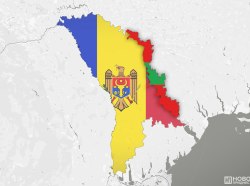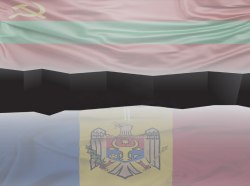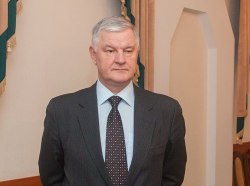The Supreme Soviet of the Soviet Socialist Republic of Moldova adopted two important documents that largely determined the further 31-year history of the two banks of the Dniester on June 23, 1990
The first document, Resolution No. 148, is the “Declaration of Sovereignty”, which laid the foundation for the future withdrawal of Moldova from the Soviet Union. It should not be confused with the Declaration of Independence of the Republic of Moldova of August 27, 1991, yet we still face a link in the chain of measures aimed at separating Moldova from the Great Power.
And the second document is Resolution No. 149 "On the Conclusion of the Commission of the Supreme Soviet of the SSR of Moldova on the political and legal assessment of the Soviet-German non-aggression pact and the Additional Secret Protocol of August 23, 1939, as well as their consequences for Bessarabia and Northern Bukovina." This is the next level here. Namely: this Conclusion blew the united Moldova up and destroyed it as a single republic. And at the same time it has greenlit the future formation of the Pridnestrovian state.
The destruction of Soviet Moldavia was deliberate on the part of the pro-Romanian nationalists, who, it is possible, wanted to alienate the territories where the very idea of integration with Romania was categorically condemned.
Let's analyze the facts.
Fact No. 1. The document says: “The Parliament of the Moldavian Democratic Republic - Sfatul Tsarii - proclaimed the independence of the Moldavian Democratic Republic on January 24, 1918. On March 27, 1918, taking into account the numerous appeals of the population of the region and the impossibility of preserving the independence of the Moldavian Democratic Republic in the existing political and military conjuncture, Sfatul Tsarii voted for the unification of Bessarabia with Romania." We face deliberate lie, because Sfatul Tsarii was not a Parliament. It had NEVER been elected by ANYONE. This is a bunch of impostors who actually seized power, but were then simply dispersed as unnecessary by the Romanian occupation administration. The “decision” of March 27, 1918 on the “unification” of Bessarabia with Romania under the control of Romanian soldiers was initially illegal. There were no "appeals" on the incorporation of Bessarabia into Romania from the Bessarabians. Moreover, in 1919-1924 alone, three major uprisings took place against the Romanian occupiers in Bessarabia - in Bendery, Khotin and Tatarbunary. Let us remember this for further analysis of June 1990 events.
Fact No. 2. The Conclusion also said: “On June 28, 1940, the USSR occupied Bessarabia and Northern Bukovina by force of arms against the will of this region population. The illegal proclamation of the Moldavian SSR on August 2, 1940 was an act of dismemberment of Bessarabia and Bukovina." This is also a lie: it is known that the population of the lands occupied by the Romanian Crown met the Red Army as an army-liberator, since Bessarabia had been completely robbed during 22 years of domination. We will not repeat the well-known truths here.
In addition, the Conclusion was based on the postulate of the unity of the so-called Romanian space, that is, the principalities of Moldova (part of which was the interfluve of the Prut and Dniester rivers) and Wallachia. Hence, the unionists conclude that Romania, which was formed in 1859 beyond the Prut, with its capital in Bucharest, allegedly had the right to annex Bessarabia. One way or another, but the left-bank part of the Pridnestrovian Moldavian Republic has nothing to do with this.
One can argue: but the PMR also includes the right-bank territories - the city of Bendery, several villages and the village of Kremenchug, which is part of the city of Tiraspol. Does the official Chisinau have the right to them?
For two reasons, it does not.
First of all, the PMR formation basis was primarily the will of the people, which was expressed in 1989-1990 in a whole series of national referendums and gatherings. This is how the residents of both the left-bank and right-bank settlements of Pridnestrovie expressed their will. This is a direct democracy, which the Moldovan authorities are afraid of and do not accept.
Secondly, using the 1992 aggression against Pridnestrovie, the Chisinau nationalist authorities violated clause 12 of their own Declaration of Sovereignty, which read: "The Soviet Socialist Republic of Moldova, as an equal subject of international relations, declares itself a demilitarized zone, actively contributes to the strengthening of peace and security." Having created armed structures and attacked the self-determined Pridnestrovie on the ruins of the USSR, having committed an act of aggression, the leadership of Moldova lost the right to democratic creation of a new unified state instead of the former Soviet Moldova.
Thirdly, the right to Pridnestrovie was automatically lost by Chisinau from June 23, 1990 in view of the phrase about "the illegal proclamation of the Moldavian SSR on August 2, 1940". If the union republic is initially illegal, then either each part of it acts as it sees fit, or the part torn off from Romania is returned to its composition. Recall that Bendery and several villages have expressed their will to become part of the Pridnestrovian Moldavian Republic as a new country - part of the former Moldavian SSR. The other right-bank part of the former MSSR with its center in Chisinau has not held any gatherings or referendums since June 23, 1990. That is, the decisions of a small group of politicians in Chisinau could in no way outweigh the free choice of hundreds of thousands of Pridnestrovian citizens. It should be reminded that Pridnestrovians voted for the independence of their country in referendums on December 1, 1991 and September 17, 2006, which again was an indicator of direct democracy.
It can be assumed that in 1990, the Chisinau authorities did not pay attention to obvious contradictions in their program documents because they considered the independence of Moldova to be a short, transitional phase on the way to rapid integration with Romania. And there, they thought, it would be possible to crush the PMR by force of arms. When the armed aggression failed, the phrase about the "illegal" proclamation of the Moldavian SSR had acted against the pro-Romanian nationalists.
It turns out that they, unwittingly, launched the independence of the Pridnestrovian Moldavian Republic.








